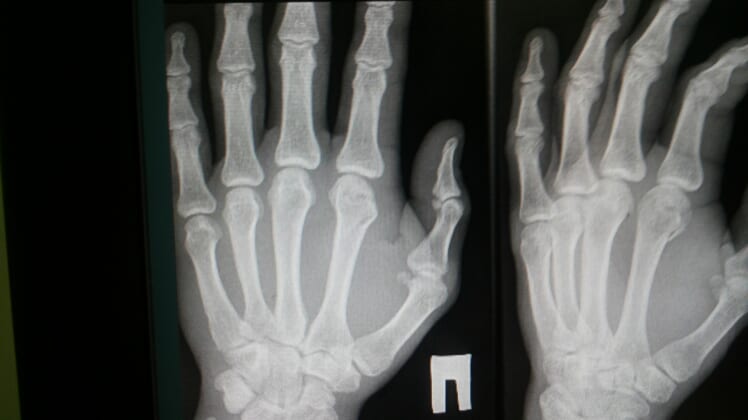
Stubbed toes, jammed fingers, and bumped shins are the stuff of everyday life, but once in a while we end up with an injury that we think might need medical attention. How do you know when to ask is this broken or sprained? Is a sprained ankle actually a fracture or when a stubbed toe is actually broken?
First, it’s important to understand what doctors mean when they talk about broken and fractured bones. Whenever the integrity of a bone is compromised, whether by a hairline crack or an all-out break, doctors call it a fracture, and the two terms can be used interchangeably.
If you’re not sure whether a bone is broken or sprained, think back to when the injury happened. The most obvious and immediate sign of a break is a snapping or grinding noise. Bones are strong, and big bones can make noise when they break suddenly, but small fractures aren’t as easy to recognize right off the bat. If you still aren’t sure whether you have a fracture or not, here are three signs to look out for—pain, swelling, and deformity.
Pain
It seems obvious that fractures would cause more pain than other types of injury, but that’s not always the case. Soft tissue can be injured too and can cause a great deal of pain. Sometimes people think that if it’s too painful to use a part of your body or put weight on it, then you’re dealing with a fracture, but that’s not true either. Sprains can be severe enough to keep you from normal activities, and sometimes you can even walk on a leg that is broken. So pain is a great sign that you’re injured, but it’s not the best indicator that you’ve broken something.
However, if there’s a part of your body that simply isn’t functioning properly, regardless of your pain level, you should go to your doctor and make sure you aren’t dealing with a fracture. Sprains and soft tissue injuries usually don’t keep you from being able to perform simple tasks like opening and closing your hand or wiggling your toes.
Swelling
Severe swelling can also indicate that a bone is fractured. While sprains can swell too, fractures usually swell more dramatically and will be accompanied by significant bruising and tenderness around the injured area.
Breaking Free From Stress Fractures
Deformity
If the area around the injury doesn’t look normal—if, for example, a finger is bent in the wrong direction—you almost certainly have a fracture. In more extreme cases, you may actually see bone sticking out of the skin. Whenever bone is visible, you need to see a doctor immediately. This doesn’t always mean calling an ambulance, but you should have someone drive you to the ER.
What to Do if You Think You Might Have a Fracture
If it’s a hairline fracture, there may not be much a doctor can do other than give you instructions for the healing period, but it’s always a good idea to be evaluated by a professional when you think a bone might be damaged. Broken bones can cause serious infections and/or permanent deformity if not treated properly. You can make an appointment with your regular doctor if the injury isn’t obviously severe and if your pain is manageable. If you’re worried you might have a more serious fracture, you can have someone drive you to the ER. If no one is available to take you and you see deformity or see bone through the skin, you should call an ambulance, especially if the injury is to one of the long bones of the arms or legs. Injured fingers and toes should be evaluated for fractures, but injuries to those bones are usually less serious.
If you’re headed to the hospital with a serious injury, don’t eat or drink anything on the way. You may need to be put under general anesthesia while your bone is realigned, and there are risks associated with using general anesthesia when you have a full stomach. And, of course, if you suspect an injury to your back or neck, you should always call 911 rather than trying to get to the ER yourself. Paramedics are trained to evaluate your injury and safely move you without causing further damage if they suspect an injury to your spinal cord.
With proper treatment—usually realignment, immobilization, and rest—most fractures heal completely within 4-10 weeks.
